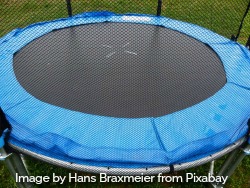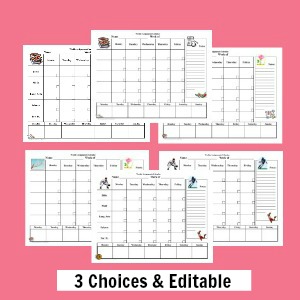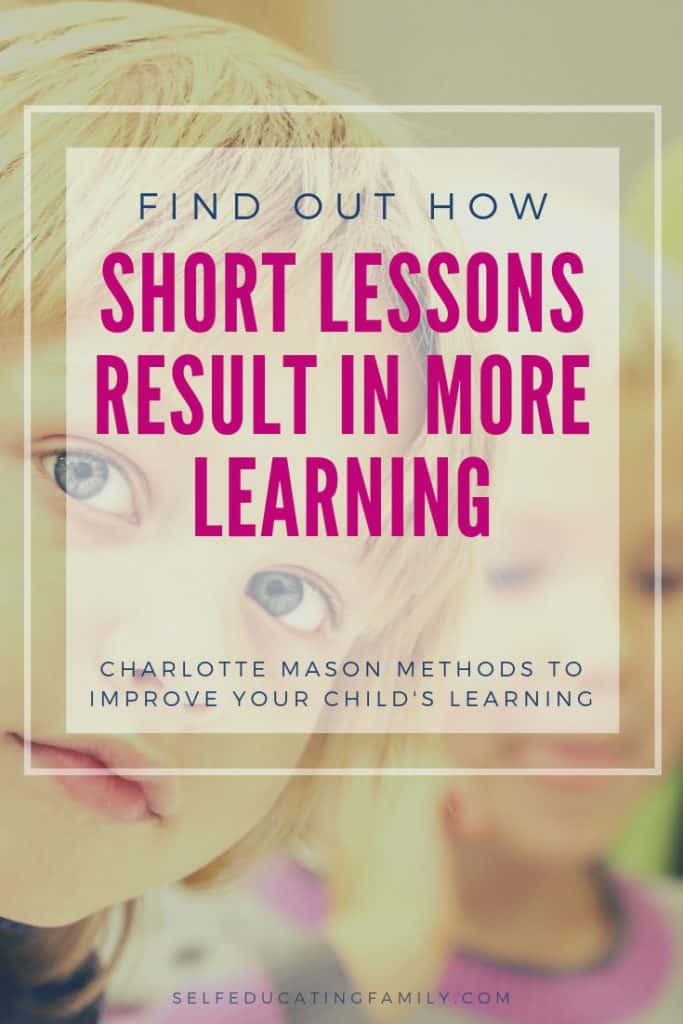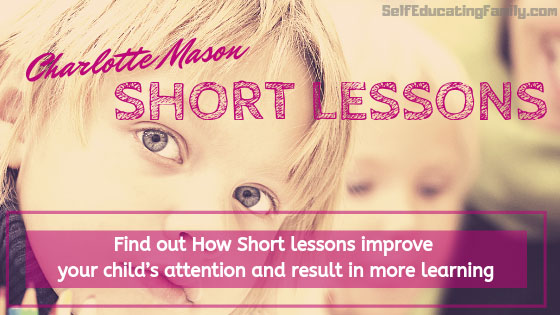Today, I am excited to have a guest post from Heidi Miller-Ford of The Unexpected Homeschooler, who will help us find out how short lessons improve your child’s attention and result in more learning.
* Disclosure: This post contains affiliate links, meaning that if you make a purchase after clicking through, SelfEducatingFamily will receive a small commission at no extra cost to you.
My eight-year-old son was squirming around in his seat. It took everything in him to concentrate. School had begun for the day and he was already staring out the window at the trampoline he loved to jump on. Sitting through a long lesson in math was not going to be easy.
All kids, and especially boys, have a hard time staying focused for long periods of time. Boys are known for having shorter attention spans, although, I have a daughter who throws that theory out with the bathwater. Trying to get school done with a child who loses interest quickly is a big challenge.
This chart shows the minimum amount of time a child should be able to focus based on age.
| Years Old | Time Able to Focus |
| 5 | 5 minutes |
| 6 | 6 minutes |
| 7 | 7 minutes |
| 8 | 8 minutes |
| 9 | 9 minutes |
| 10 | 10 minutes |
| 11 | 11 minutes |
| 12 | 12 minutes |
This doesn’t seem like much time, does it?
Charlotte Mason

Charlotte Mason was a British educator in the early 1900s, who had a large impact on the education system in England. Her style of teaching is popular amongst many homeschoolers. One of the foundational elements she implemented was short lessons.
She believed lessons in the younger years should be no more than 15-20 minutes. At middle school age 30 minutes, and once in high school, a lesson was extended to 45 minutes.
Are you wondering how your child can learn anything in that amount of time?
How Do Short Lessons Help?
I know these times don’t seem like a lot, especially when we live in a world where children are sent to school eight hours a day. But I believe Charlotte was on to something. It is possible to complete school with shorter lessons and accomplish more than they would in an eight-hour day.
Here’s why:
Get More Done
While 15-20 minutes doesn’t seem like a lot, you will be surprised how this adds up over the course of a year. I have witnessed this with my own children. I used several programs which took 15 minutes a day for the lesson and was amazed at what my kids covered by June.
When I shortened the time, my children absorbed more information because they were fully focused. These became some of their favorite subjects. This doesn’t mean they weren’t challenged. They weren’t fatigued from working for extended periods of time.
Motivating

When a timer is set, our brain tries to complete a task before it goes off. It’s human nature. Your child’s the same with his school work. It’s a natural motivator for him to get his lesson done. He will focus more and work harder. This is helpful in a subject he dislikes.
When we first started doing this, my daughters were a little shocked and couldn’t believe they finished in such a short amount of time. My girls are happy, willingly work on those subjects first, and do the floss when they are done!
My girls are happy, willingly work on shorter subjects first, and do the floss when they are done!

Energizing
When you change the subjects often, the student’s brain is getting a break. It’s like needing a change of scenery. Who doesn’t get tired of looking at the same thing for a long period of time? They are refreshed with new materials and ready to tackle the next subject.
Habit Training of Attention
Holding our children’s attention is one of the biggest struggles we face when teaching them. It’s also a necessary skill in life. Can you imagine a brain surgeon who can’t focus?
Over time, you can build the habit of attention, which keeps your child focused during his lessons. As a result, this engagement equals more learning. Isn’t that what we are shooting for?
Habits can take a while to create so patience is important. Rome wasn’t built in a day!
Start with a timer and set it for five minutes. If your child can’t handle that, start with less. When the timer goes off, the lesson is over. If this is easy for him, increase the time by one or two minutes the next day.
However, if five minutes is a struggle, try decreasing by a minute each day until your child can stay focused the whole time. When that happens, you have found the sweet spot where he needs to start.
It’s important to stop the lesson BEFORE he becomes bored or that will be the habit you are creating.
Structure of a Short Lesson
| Time Recommendations for Short Lessons by Grade Level: | |
| Grades 1-3 | 15-20 minutes |
| Grades 4-6 | 20-30 minutes |
| Grades 7-9 | 30-45 minutes |
| Grades 10-12 | 45-60 minutes |
How you structure your lessons is just as important as the length of time. If you keep your lessons short, but they’re dry and boring, a one-minute lesson won’t keep anyone’s attention.
Ambleside has some example schedules showing how your lessons and days can be split up. Simply Charlotte Mason has one as well.
You will notice the variety of lessons each day. A challenging subject is followed by a lighter more enjoyable one. This keeps the child interested and excited about what comes next.
Make sure the work you give your child is at the appropriate level. Nothing zaps your child’s interest like work that is too hard. It’s fine to have challenging work, just not beyond his capabilities.
Natural Rewards for Completing Work
Charlotte Mason believed natural rewards would motivate a child to finish his work. She referred to them as “the natural consequences of his good conduct”.

I used to send my son outside to jump on the trampoline for five minutes. This helped him get the wiggles out, get some fresh air, and was something he looked forward to. You may need a completely different reward for your child.
Some suggestions are:
- Shooting baskets on a small indoor basketball hoop
- Jumping rope on the back porch
- Drawing a picture in a sketch pad
- Riding scooters (the old gym glass ones) around the kitchen floor- My kids LOVE these!
- Jumping on a mini trampoline- my 9-year-old daughter begs for this. (Are you seeing a pattern here?)
- Playing an independent game at the table- A good example is the peg game found on the tables at Cracker Barrel restaurants.
- Using clay, Playdoh, slime, or Silly Putty
- Building a puzzle
- Reading a favorite book (if you have a book lover)
- Playing cars on a mat
- Playing Legos
The list could go on and on. The important thing is asking your child what he loves to do in his free time, which guarantees you will pick an idea he’ll be excited about.

You can dangle these rewards in front of your child like a carrot during his least favorite subjects. You’ll be surprised how hard he works. Make sure it’s quality work though or he needs to go back and do it again.
This concept prepares children for real life. As adults, we often have activities we’d rather do, but we must finish our work first. This will benefit any child who learns it early.
Assignment chart
I have seen first-hand how using an assignment chart can be an intrinsic motivator. While it may not be the same as riding scooters, there is a sense of satisfaction we all get when we check off a list.

Seeing a to-do list get smaller gives your child a light at the end of the tunnel and pushes him to keep going. This is a natural reward.
I have created my kid’s assignment charts with checkboxes built into them for this purpose.
Conclusion
Your day will be shorter with more free time in the afternoon to explore other interests. And I don’t know about you, but I’m all for learning in a shorter amount of time.
Short lessons effectively motivate and energize your child to get his work done. A 15-minute lesson where your child listens and actively participates is far more effective than a 45-minute lesson where he is thinking about the trampoline and how soon he can go jump on it.

Want to remember this article? Pin it to your Pinterest board!

